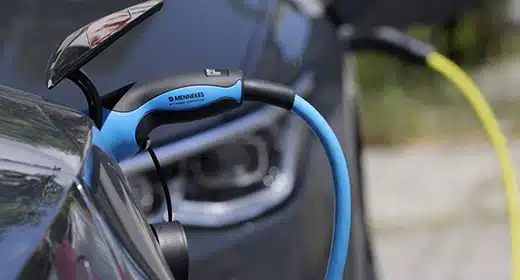The price gap between electric vehicles and gas cars has narrowed significantly over the past year.
 ENERGYWIRE | Electric vehicles are getting cheaper as inventory rises and battery costs fall — a trend that experts say bodes well for the Biden administration’s goals to cut car pollution.
ENERGYWIRE | Electric vehicles are getting cheaper as inventory rises and battery costs fall — a trend that experts say bodes well for the Biden administration’s goals to cut car pollution.
The average price of an EV is now about $53,000, nearly 20 percent cheaper than a year ago. Gasoline-fueled vehicles, meanwhile, have slightly increased in cost, averaging $48,000.
That price gap will likely narrow even further in the coming years, experts say, removing a significant barrier to widespread EV adoption.
“We need to be producing a lot of vehicles at prices very much in line with the prices of internal combustion engine vehicles,” said Albert Gore, executive director of Zero Emission Transportation Association. “We’re very, very close to that right now.”
The Biden administration is counting on EVs to slash transportation pollution — the country’s single-largest contributor to climate change — and reach a net-zero economy by 2050. The Inflation Reduction Act invests billions in electrifying the country’s cars and trucks, while EPA’s proposed tailpipe emissions rule could effectively make 67 percent of new light-duty vehicles electric by 2032.
EVs only make up about 8 percent of total vehicle sales, but inventory has skyrocketed, increasing by 271 percent since last September, according to industry analyst Cox Automotive.
That first-ever surplus of EVs — along with price cuts, production of cheaper EV models, and availability of federal and state incentives — is influencing a drop in prices, said Stephanie Valdez-Streaty, director of industry insights at Cox Automotive, in an interview.
Valdez-Streaty said Inflation Reduction Act incentives, including a $7,500 tax credit for consumers who purchase certain EVs, make up 8.1 percent of the average price for buyers. The Biden administration recently announced that it plans to allow auto dealers to offer that credit at the time of purchase, in the hopes that it will help dealers sell more EVs.
Lower battery costs
In September, the global average price for lithium-ion batteries dropped below $100 per kilowatt-hour for the first time in two years.
That’s largely due to a decline in the cost of critical minerals, with the price of lithium carbonate and lithium hydroxide dropping by 50 percent since the beginning of this year, according to industry consultant Benchmark Mineral Intelligence.
That, in turn, has helped drive down the cost of EVs, experts say, as a battery pack can be up to 50 percent of the cost of the vehicle.
Evan Hartley, an analyst at Benchmark, said in a statement that the decreasing cost of batteries could allow companies “to sell mass market EVs at comparable prices to [internal combustion engine] vehicles, with the same margin, improving the attractiveness of the EV transition for both consumers and automakers.”
The cost of lithium-ion cells is averaging $98.2 per kWh, close to the $80 per kWh needed for EVs to reach price parity with gas vehicles, according to Benchmark.
Increased demand in the transportation and energy sectors are also helping drive down the costs of battery packs, Gore said. In an interview, he predicted that tax credits in the Inflation Reduction Act will further encourage a downward curve by incentivizing production in the United States of lithium-ion battery cells.
High consumer demand for EVs has decreased prices throughout the supply chain, Gore said. And as manufacturers produce more battery packs and critical minerals, production will get more efficient, he predicted.
“We’re seeing constant innovation in the way batteries are made, the way vehicles are made,” Gore said. “We expect this to be a long-term trend in costs coming down, and that’s going to be a great thing across the industry and for consumers.”
Need for cheaper options
But to really make a dent in EV prices, automakers have to start looking beyond luxury vehicles, said Ingrid Malmgren, policy director at Plug In America, a nonprofit advocacy group.
“I think in part because manufacturers want to demonstrate that electric vehicles can meet all the functional needs of a gas vehicle, they often make big sort of high-end, fancy electric vehicles, and there aren’t as many affordable budget option EVs on the road today or on the market today,” Malmgren said in an interview.
EVs cost less than gas vehicles over their lifetime, due to fuel and maintenance savings, Malmgren said. But she said the higher upfront price tag and lack of used options has made EVs less accessible.
A survey from Cox Automotive released in June found that while many more consumers are considering buying an EV, 43 percent thought they were too expensive.
Used EVs are starting to come down in cost, however, as more enter the second-hand market. Currently, the average price of a used EV is about $41,000 while a gas vehicle is about $34,000, according to Valdez-Streaty with Cox Automotive.
Federal tax credits and additional state or utility incentives could help make EVs more affordable while bringing manufacturing to the United States, Malmgren said.
“What we hope to see is that these prices will continue to decline, electric vehicles will be more affordable and that more models will be manufactured that are not necessarily luxury models, so that they’ll be more affordable to a broader range of drivers,” Malmgren said.
Reprinted from E&E News with permission from POLITICO, LLC. Copyright 2023. E&E News provides essential news for energy and environment professionals.








































